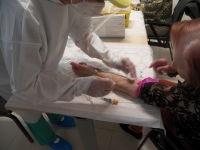Health
Half of healthcare workers suffer from sleep problems due the COVID-19
A 84% are worried about the Corona
USPA NEWS -
The fight against the Coronavirus pandemic has involved, in the first place and throughout the world, health workers. Many of them, even in developed countries with reliable health systems, have faced the disease of their patients with a serious risk to their own safety due to the lack of effective protection measures and the close contact they have with the infected. Endless working hours are linked to the material problems and the psychological effect of seeing their patients and their own colleagues die, which translates into physical and mental health problems for health workers who work on the front line against COVID-19.
A study about 1,002 healthcare workers who are currently working in health institutions in the U.S. - a 53% of them are male, while 47% are female -, reveals that 51% of healthcare workers rate their sleep as fair, while 14% confirm that they sleep excellently. Also one in every three healthcare workers in the U.S. sleep poorly during the COVID-19 pandemic. Five hours is the average sleep hours per day of healthcare workers in the U.S. during the COVID-19 Pandemic. Many healthcare workers experienced sleep disorders like insomnia (41%) or nightmare (27%) but a 21% of U.S. Healthcare workers report that they do not experience any sleep disorders. The figure of healthcare workers who experience narcolepsy and other sleep disorders represent 5% and 6% respectively. A 84% of healthcare workers in the U.S. are worried about bringing the Coronavirus home from work.
The results of this study, carried out by Sleep Standards, can be extrapolated to any other country in the world. Since last February, the pandemic requires health workers to make a superhuman effort to contain the spread of the disease. The global nature of the infection, which affects almost the entire planet, keeps the danger of contagion alive, especially when in regions such as Europe, borders were opened at the time when the number of infections fell to controllable levels and the mobility between regions of the same country and between different countries. And the risk keeps health workers around the world on alert.
In Europe, the disease has affected health workers with the same virulence as the general public. In Bulgaria, as of mid-June, 318 positives had been reported among healthcare professionals. In Croatia there were 197, in France 25,727, in Italy 24,683, in the Netherlands 8,000, in Portugal 2,940, in Romania 103 and in Spain 51,849, of whom 76 died. Only in Italy more health workers died: 178, according to data from the European Federation of Salaried Doctors (FESM).
Front-line health and other workers (nurses, doctors, ambulance drivers, case identifiers, etc.) may experience extreme stress due to higher work demands and intense schedules. In addition, they may experience additional stressors from the stigma associated with being in a close environment with patients with COVID-19.
“Across the Western Pacific Region, COVID-19 is placing enormous strain on health and economic systems. Apart from direct threats to personal health, safety and livelihood, the pandemic also has significant implications on mental health and psychosocial well-being. Adversity is an established risk factor for mental health problems, thus the impact of COVID-19 on mental health is expected to be large, diverse and far reaching. Mental health and psychosocial support (“ŽMHPSS)“Ž are essential components of a public health response to COVID-19,“ said the World Health Organization (WHO). For this, stressed the importance of “ensure access to mental health and psychosocial support services, including on-site services, telephone-based support or other remote options“ for all responders against the COVID-19.
Liability for this article lies with the author, who also holds the copyright. Editorial content from USPA may be quoted on other websites as long as the quote comprises no more than 5% of the entire text, is marked as such and the source is named (via hyperlink).






